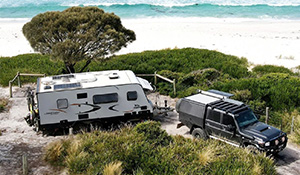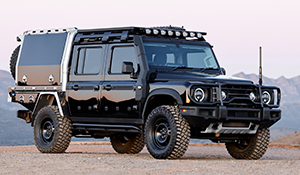1989 Daihatsu Feroza
Powered by a 1.6-litre single overhead-cam fuel injected 16-valve engine, it delivered 70kW of power at 5700 rpm and 128Nm of torque at 4800 rpm.
The engine was matched to a five-speed gearbox and two-speed transfer case. Suspension was double wishbone and torsion bar at the front, with leaf springs and live rear axle.
The Feroza was essentially a two passenger vehicle although a rear seat provided all up seating for four. The Feroza was an attractive 4WD with smooth sporty lines, angled blunt grille, raked windscreen, bulging wheel arches and rear mounted spare wheel.
A unique feature was its removable rear top. It was available with either soft top or resin hardtop, in two specification levels - the DX or upmarket EL.
The base DX model with soft top could also be ordered with an optional resin sunroof which fitted over the driver and front passenger. Likewise the resin hardtop EI model could be ordered with Daihatsu's easy-fold canopy, which then transformed the hardtop into a sporty soft top. Either way it was possible for buyers to have the best of both worlds.
At time of launch the Feroza DX soft top was priced at a very competitive $16,990, with the resin-top EL $19,950. Other options included a limited slip rear differential and metallic paint. A rear seat was also optional for the soft top.
The EL Feroza incorporated the smart resin-top with large wrapover side windows, three-stage adjustable suspension, a 'chrome pack' which included chrome-plated wheels, grille, door handles and side mirrors, two-tone metallic paint, LSD and canopy. With all these options the EL was priced at $23,300. Air-conditioning was a further dealer option.
Expansion
The Feroza range was soon expanded to three models: a DX soft top, a DX hard top and an EL hard top. The Feroza offered a number of removable tops and was a fun compact marketed to a young audience.
It was a highly manoeuvrable and easy to drive "multipurpose" 4WD with good off-road ability, although under powered in some situations.
The Feroza was the only compact 4WD with a removable hard top, and its 4WD image was further enhanced with extensive galvanised body parts, sump guard, and built in roll bar.
In late 1989 the Feroza went further upmarket with a new version called the Feroza EL II. The new model had sports bucket seats with better lumbar and side support, and a four speaker sound system featuring an AM/FM stereo radio and cassette. New cloth seating front and rear and storage binnacles were introduced in the rear.
Externally the new Feroza was blazoned with the addition of "16-valve EFI" striping on the doors and gold pin striping on the rear quarters. To add extra lustre there was a choice of three two-tone metallic paint finishes featuring charcoal, red mica and blue, with silver the second colour.
A removable sunroof was also added.
Power steering was standard, along with a three-stage adjustable suspension. This Daihatsu claimed, allowed the driver to adjust the EL II to any road condition while on the move. The EL II was only available in hard top form and was priced at $20,990. A limited slip diff and air-conditioning were options.
By the end of 1990 Daihatsu announced the release of a revised Feroza, the EL III. It had the same specifications as the superseded EL II with some minor additions to the fuel injection system's air-intake.
Daihatsu claimed the EL III had the same peak power and torque as before, but that the Feroza's torque curve was now flatter, reaching max torque of 126Nm at 3000 rpm.
The EL III featured central locking, power windows and power wing-mirrors as standard. Guards were flared all round and the front and rear bumpers extended. Wider 225/70 R15 Dunlop Grand Trek tyres on a wider 6JJ x 15 wheels were fitted. There were new cloth seat inserts and matching door trim, a different grille treatment, and a new colour, 'San Remo green'.
The Feroza range now consisted of a DX model soft top and resin top, and the EL III hard top.
The EL III was an ideal sports utility with bold, wide body styling, colour-coordinated body flares, and wide wheels. The EL III was well appointed with standard anti glare mirror, head restraints, rear window demister, rear washer/wiper, integral and rear roll bars, extended front bumper and lower mount for the spare wheel.
There were power windows and central locking, power steering, electric mirrors, three way adjustable suspension, remote rear door lock, full carpeting, opening rear quarter windows, front door arm rests, locking glove box, front and rear mud flaps, luggage room light AM/FM stereo radio cassette with four speakers, full fabric moquette seats, removable sunroof and resin top, plus optional air-conditioning, limited slip diff roof racks, tow bar and soft top canopy.
In the rough the compact Feroza was sure footed with sturdy suspension and good ground clearance. It had a tight turning circle and a commanding driving position providing excellent visibility despite wide B pillars.
The 1.6-litre engine was not an impressive off road performer, and was noisy at higher speeds. The independent suspension and the three-position electronically controlled dampers did not provide an outstanding ride, although handling was light and responsive.
The Feroza EL III received an update for summer and was promoted as a sport and leisure machine. There was a new bolder grille and rear bumper, with integrated tail lights. The new Feroza sported a stronger, 70mm longer front bumper bar, wide wheels and body coloured flares. The rear styling was strengthened with bigger bumper bar and integrated tail lights.
A five speed manual transmission and dual range transfer case allowed maximum 4WD performance off road.
In 1990 a special edition sports 4x4 Feroza was launched in conjunction with Daihatsu sponsorship of the Uncle Tobys Super Series for Australia's top iron men. The new Feroza although based on the existing model provided a new dimension to the Feroza range and came in just one colour, white. The New Feroza was all white, with matching grille, bumper bars and door handles. The wheels were also white, with the clean styling package topped with bold blue striping along the side of the compact 4WD. An adjustable sunroof was retained.
The Sports Feroza was available in limited numbers with an easy fold canopy. Revisions to seating included high back, split rear seats to complement the sporty body hugging front seats.
Thereafter little changed with the Feroza, until 1992 when an overdue updated range arrived and heralded the arrival of the Feroza II SXP Wide Track model.











